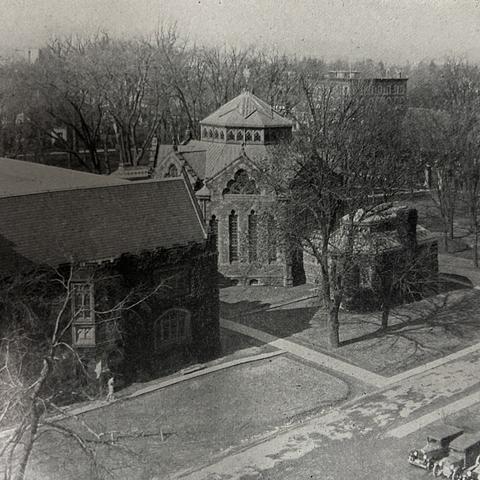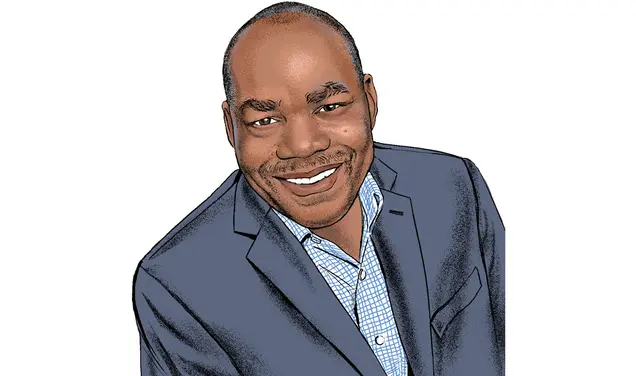Revolutionary Princeton Depicted
Letters of Charles C. Beatty 1775, Recent Gift to University, Reflect Thought and Action of Campus in those Stirring Times
A picture of Princeton during Revolutionary times is contained in thirteen letters of an undergraduate of that day which have just been presented to the University. The epistles were written by Charles C. Beatty of the Class of 1775 to his sister, Betsy, and include a period from May 17, 1773, to November 8, 1775.
The gift of the letters has been made by Dr. Ralston F. Elwell of Philadelphia, and his sister, Florence Beatty Bixler, wife of C. Edwin Bixler ‘92. The letters themselves are now on display in the Treasure Room of the University Library.
These old missives establish the fact that as early as May, 1775, the college was carrying on military preparations, having its own company of men while another company was drilling in the town.
“How can your patriotic spirit be so dull, when all around is war and bloodshed,” Beatty wrote to his sister. “Certainly, you have heard of the skirmishes at Boston, and can you not sympathize with the distressed people there. You need not speak here without it is about Liberty.
“Every man handles his Musket and hastens his preparations for war. We have a company in College of about 50 officers and all among ourselves, another company they have in town.”
This letter is the first supporting evidence of a reference in Alexander Gordon’s “Anecdotes” that such an undergraduate military existed in Princeton.
Homespun for Patriotism
This same letter further discloses the fact that the graduating class had decided to wear only American-made cloth at its Commencement. “Our class, to show their patriotism, intend commencing in Homespun,” Beatty writes. “How I shall get mine I cannot tell, perhaps your goodness can find some scheme….” His sister took the hint, later letters disclose, and supplied the cloth, but not until Beatty had written several more persuasive letters on the subject. He must have the cloth by the middle of August, he writes: “I suppose and am sure you will have it made as well as possible. Any colour that will suit best and in accordance to your fancy will please me.”
The hitherto-unrecorded date of the marriage of Ann Witherspoon, daughter of President John Witherspoon, to Samuel S. Smith of the Class of 1769 is also disclosed in the group of letters. “We also have had a wedding this last week in Princeton,” he writes. “Yes, Princeton forgot the sad aspect of affairs and joined in assisting connubial bliss. Last Wednesday evening [June 28, 1775] Miss Anny Witherspoon as married to Mr. Saml. Smith of Pequea. The students had the latter end of the week as holidays upon account of it. So great is the joy and rejoicing in this house.”
President Witherspoon later became a prominent figure in Continental Congress and was one of the signers of the Declaration of Independence. Samuel Stanhope Smith, his son-in-law, became president of the College in 1795.
His Sister Betsy
Young Beatty was the son of the Reverend Charles C. Beatty, pastor of Neshaminy Church and a Trustee of Princeton, who died in the West Indies on a money-raising tour for the College. His sister Betsy was the “adorable Laura” of the “Fithian Letters,” published some years ago by the Princeton Historical Association. Philip Fithian, of the Class of 1772, married Betsy in October, 1775.
Fithian’s Master of Arts diploma has also been given to Princeton by Dr. Elwell and Mrs. Bixler. It is one of the small engraved diplomas and bears the signature of President Witherspoon, John Redman, John Rodgers, William Shippen, James Goldwell, and Isaac Reed. The attached seal of the College on a blue ribbon, the colors of the American Whig Society, is in perfect condition.
From Deerfield, N.J., in 1773 young Beatty writes of current village happenings, such as weddings, and the fact that someone’s house is “newly boarded and it cuts a flaming dash,” and that “they have got the Canopy suspended in the new meeting house, and Mr. Green durst not preach for fear it should fall on his head.” Every one is well “except Mrs. Green who has had the Disease of Scolding these several Days and it yet continues very bad and had like to have cost Reading a broken head.” Mr. Green was the Reverend Jacob Green, Trustee and Vice-President of Princeton, who also had a private school at Deerfield.
Ulterior Motives
Writing from Nassau Hall in March, 1774, Beatty gently chaffs his sister about letters to Philip Fithian, which he had entrusted to him, and suggests that his older brother, Dr. John Beatty (Princeton 1769), was visiting Princeton not solely to hear the oration or to see him. On the contrary, he was by this time engaged to Mary Longstreet of Maybury, Princeton, and later in that month their marriage took place. Charles writes to his sister, April 3: “I was quite sorry when I was at Brother’s wedding that you could not be there and been a partaker in some of the pleasures of the night….But now I know you will be desirous to know some of the particulars, such as What Clothes the Bride and Groom had on, who were bridesmaids and groomsmen,” but he had not time write it out….
Says he “drank tea yesterday afternoon with Mrs. Beatty and Miss B. Sergeant and spent the evening very agreeably.” Evidently the tea party on the campus in January, when all the tea in college was burned, had not had a deterrent effect on the village.
In August 1774 he writes her a teasing disquisition on a place in Virginia called Hobs-Hole–a place of which “the name does not indicate much on hearing it.” But one must not judge of Hobs-hole by its name but by its contents, and it appears that the place just now contains “no less than little Philip, the great gallants among the Ladies, the captivator of their hearts,” and in fine “the man whom heaven has designed to make one woman happy with.” This alters the case and Hobs-hole no longer appears rough or ridiculous in sound, but “gives pleasure each time it is named.” The gentleman in question was, of course, Philip Fithian.

General Irony
April, 1775, writing from Nassau Hall, he chaffs her about her engagement and ironically wonders who it can be that has won her affection, and hopes “he is not such a patriot but will let you have tea, from which many advantages will arise–if you have tea you will have visitors enough, you will see every old wife in the neighbourhood each week, you will hear all the news that is stirring, and many other useful things.” …
He speaks about Commencement assignments already made, thanks her for offering to do his mending, and slips in a sentence “something within me that says I regard my sister Betsey more than any one in the world.”
The last letter of the collection is dated from Nassau Hall on November 8, 1775, whither he had returned after graduation– “This day I arrived at Princeton, to my great joy, for I longed to return to my old habitation and my only home….As things appear I shall live happy this Winter. A great number of Students in College. The Junior Class at present consists of 45 and no doubt will yet be increased.”
Two months later almost to the day, on January 5, 1776, he enlisted in Colonel Moyne’s Pennsylvania battalion and during the following year he saw service in northern New York, more particularly at Ticonderoga. He returned safely to Chester County, Pennsylvania, but in February, 1777, was killed by the accidental discharge of a musket.
In July 1776, Philip Fithian joined the Army as a chaplain; and in October 1776, he died of camp fever. His widow later married his cousin Joel Fithian.











No responses yet